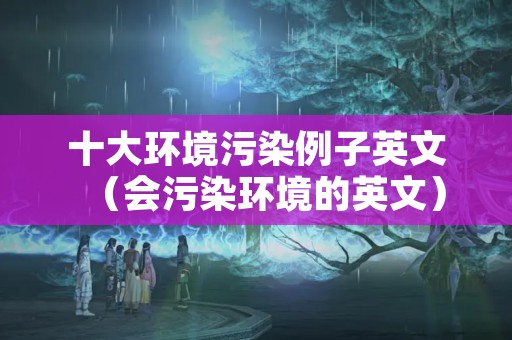十大环境污染例子英文(会污染环境的英文)
- 关于雾霾
- 2023-04-24
- 193
找了很多关于污染的网页,无意发现了这一页,具体地让偶都汗了好几下~~~好佩服自己,呵呵顺便把19,20,21世纪有的都给你找来了,呵呵。不过都是关于空气污染的。
谁能帮我找到20世纪全球十大污染事件的英文简介

找了很多关于污染的网页,无意发现了这一页,具体地让偶都汗了好几下~~~好佩服自己,呵呵
顺便把19,20,21世纪有的都给你找来了,呵呵。不过都是关于空气污染的。
1827 French scientist J.B. Fourier outlines atmospheric process by which earth’s temperature is altered, using a hothouse analogy.
1880s First U.S. municipal smoke abatement laws aimed at reducing black smoke and ash from factories, railroads, and ships. Regulation under local boards of health.
1909 Glasgow, Scotland, winter inversions and smoke accumulations kill over 1,000. Preparing a report about the incidents, Dr. Harold Antoine Des Voeux coins term “smog” as a contraction for smoke-fog.
1921 General Motors researchers discover tetraethyl lead as an anti-knock gasoline additive. Despite warnings about its danger, the new gasoline goes on sale without safety tests within 14 months.
-NWCAPP Home
-Northwest Air Priorities
-Promising Projects
-Air Quality in the Pacific Northwest
-News
-Northwest Air Summit
-Leadership Team
1926 First large-scale survey of air pollution in U.S., in Salt Lake City.
1928 PHS begins checking air pollution in eastern US cities, reporting sunlight cut by 20 to 50 percent in New York City.
1947 Los Angeles Air Pollution Control District formed; first air pollution control bureau in the nation.
1948 Air pollution inversion episode in Donora, Pennsylvania, kills 20 people and makes 40 percent of the town’s 14,000 inhabitants ill.
1948 600 deaths in London due to killer fog.
1949 Cleaner Air Week is started by the Air Pollution Control Association to commemorate the Donora air inversion.
1949 First national conference on air pollution sponsored by Public Health Service.
1950 Poza Rica killer smog incident leaves 22 dead, hundreds hospitalized in Mexico.
1952 Sulfur-laden smog covers London and is responsible for 4,000 deaths over a two-week period.
1953 New York smog incident kills between 170 and 260 in November.
1955 Congress passes Air Pollution Research Act.
1956 Another killer smog in London; 1,000 die.
1963 Air pollution inversion in New York leads to 405 deaths.
1966 Air pollution inversion in New York leads to 168 deaths.
1967 Air Quality Control Act passed by Congress, setting timetable for states to establish their own air quality standards.
1970 First Earth Day celebration.
1970 Congress passes the Clean Air Act, allowing the newly created Environmental Protection Agency to set national air quality standards. Also allowed states to establish their own stricter standards, which California did.
1975 Catalytic converter developed and used on auto emissions systems. Cuts hydrocarbon and carbon monoxide emissions by 96 percent and nitrogen oxides by 75 percent.
1977 Revised Clean Air Act Amendments passed by Congress, providing more time for areas with more serious air quality problems to comply with standards.
1980 With phase out of lead in gasoline, blood-lead levels drop by 50%.
1984 Methyl isocyanate gas release from Union Carbide plant kills 16,000 people.
1987 Indoor Air Quality Act first introduced into Congress to address the pervasive problem of indoor air pollution.
1988 EPA establishes Indoor Air Division of the Office of Air and Radiation to address indoor air quality issues.
1988 Congress approves Indoor Radon Abatement Act to assess extent of indoor radon problem, educate public on hazards of exposure and improve testing and repair technology.
1989 EPA publishes first Toxic Release Inventory.
1990 National ban on smoking aboard domestic flights enacted, protecting passengers from the dangers of secondhand smoke.
1990 Further revisions to Clean Air Act Amendments are passed by Congress, this time providing more time to comply with standards but requiring that cities implement specific air pollution control measures.
1993 EPA reviews ozone standard, but chooses not to revise it.
1997 EPA strengthens the standard for particulate matter air pollution.
1999 Clinton Administration announces federal plan that would for the first time require all private passenger vehicles– including sport-utility vehicles and diesel-powered vehicles– to meet the same tough clean air standards.
2000 EPA passes new rule for diesel, capping sulfur levels in diesel fuel at 15 parts per million by 2007.
2003 EPA proposes new nonroad diesel emissions reduction plan.
世界上的最严重的十大环境污染事例有哪些?
一、北美死湖事件
1、美国和加拿大是西半球工业最发达的地区,每年排放二氧化硫2500多万吨。1970年开始,这些工业最发达的地区出现了大面积酸雨区,酸雨甚至比的上柠檬汁,许多湖泊的生物都死乐,森林树木枯萎。
二、卡迪兹号油轮事件
1、1978年3月16日,美国2超级油轮“卡迪兹号”,载着伊朗原油向鹿特丹驶去,在航行到法国布列塔尼的海岸触礁然后沉没,22.4万吨的原油漏出,污染了超过350公里长的海岸线。
2、光是牡蛎就死掉上千多吨,而海鸟也死亡接近2万多吨。这次的事件损失1亿多美元,污染和治理费用高达5亿多美元,而被污海洋生态环境造成的损失难以估量。
三、墨西哥湾井喷事件
1、1979年6月3日,墨西哥石油公司的平台钻机打入水下3000多米深的海底油层时,突然发生严重井喷原油泄漏,污染了这一带的海洋环境。
四、库巴唐“死亡谷”事件
1、巴西圣保罗的库巴唐市的企业主只顾赚钱,随意排放废工业气体工业废水,谷地浓烟弥漫、臭水不断,有20%的人得了呼吸道过敏症,使2万多贫民窟居民严重受害。
五、西德森林枯死病事件
1、原西德的森林被酸雨侵蚀的有34%染上枯死病,每年枯死的蓄积量占同年森林生长量的21%多,先后有80多万公顷森林被毁。
2、受酸雨的影响,在巴伐利亚国家公园的每棵树都得了枯死病。黑森州海拔500米以上的枞树相继枯死,全州57%的松树病入膏荒。
3、巴登-符腾堡州的“黑森林”,是因枞、松绿的发黑而得名,是欧洲著名的度假圣地,也有一半树染上枯死病,树叶黄褐脱落,其中46万亩完全死亡。汉堡也有3/4的树木面临死亡。当时鲁尔工业区的森林里,到处可见秃树、死鸟、死蜂,该区儿童每年有数万人感染特殊的喉炎症。
六、印度博帕尔公害事件
1、午夜,在博帕尔市郊的“联合碳化杀虫剂厂”一座存贮45吨异氰酸甲酯贮槽的保安阀出现毒气泄漏事故,形成了一个方圆25英里的毒雾笼罩区。
2、2500人死于这场污染事故,另有1000多人危在旦夕,3000多人病入膏肓。在这一污染事故中,有15万人因受污染危害而进入医院就诊,事故发生4天后,受害的病人还以每分钟一人的速度增加。这次事故还使20多万人双目失明。
七、切尔诺贝利核漏事件
1、1986年4月27日早晨,乌克兰切尔诺贝利核电站一组反应堆突然发生核漏事故,引起一系列严重后果。带有放射性物质的云团飘到丹麦、挪威、瑞典和芬兰等,导致瑞典东部沿海地区的辐射剂量超过正常情况时的100倍。
2、核事故使10%的小麦受到影响,而还受到水源的污染,使前苏联和欧洲国家的畜牧业都被影响。
八、莱茵河污染事件
1、1986年11月1日,瑞士桑多斯化学公司仓库起火,导致装有1250吨剧毒农药的钢罐爆炸,硫、磷、汞等有毒有害物质随着百余吨灭火剂进入下水道,排入莱茵河。
2、剧毒物质有70公里长,随着莱茵河以每小时4公里速度向下游流去,造成了河里生物大面积死亡,沿河的自来水厂全部关闭,全国与莱茵河相通的河闸全部关闭。
九、雅典“紧急状态事件”
1、1989年11月2日上午9时,希腊雅典中心大气质量监测站显示,空气中二氧化碳浓度318毫克/立方米,超过国家标准59%,发出了红色危险讯号。11时浓度升至604毫克/立方米,超过500毫克/立方米紧急危险线。
2、中央政府当即宣布雅典进入“紧急状态”,禁止所有私人汽车在市中心行驶,限制出租汽车和摩托车行驶,并令熄灭所有燃料锅炉,主要工厂削减燃料消耗量50%,学校一律停课。
十、日本“四大公害事件”,水俣病
1、1956年发生在熊本县水俣市,原因是氮肥公司将含有甲基汞的废水排入海中,造成居民由于捕食海中鱼类造成水银中毒。
2、第二水俣病:昭和电工公司将含汞废水排入海中所致。
3、四日市哮喘:工业排放硫氧化物到大气中导致的大气污染。
4、痛痛病:矿山企业排放大量镉到河里造成的水质污染。
参考资料来源:百度百科-环境污染
求翻译:全球十大环境问题
1、气候变暖 :climate warming
2、臭氧层破坏:ozone depletion
3、生物多样性减少:biodiversity decrease
4、酸雨蔓延:acid rain spread
5、森林锐减 :forest plummeted
6、土地荒漠化:land desertification
7、大气污染 :air pollution
8、水体污染:water pollution
9、海洋污染:Marine pollution
10、固体废物污染:solid waste pollution
声明:本网页内容旨在传播知识,若有侵权等问题请及时与本网联系,我们将在第一时间删除处理。
E-mail:langhai8@163.com
本文链接:https://www.wumai.net/wumai/20221129093505.html